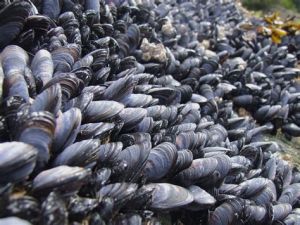
Mytilus edulis is commonly known as the blue mussel. Their beds are composed of dense layers of live and dead mussels bound by the byssus threads* and variable amounts of accumulated sediments (OSPAR Commission, 2008).
The blue mussel is present in boreal and temperate waters, with a large distribution (Soot-Ryen, 1955 in OSPAR Commission, 2008). They can occur in fully saline to highly estuarine waters and from habitats highly exposed to waves to very sheltered habitats.
Intertidal beds of the blue mussel are specific to the OSPAR area; the majority are found in the Waddensea and British coastal waters, but they also present all along the coast of France and Ireland (Jones et al., 2000 in OSPAR Commission, 2008).
Most Mytilus beds under threat occur in the Waddensea and southern British coastal waters. "The extensive, heavily exploited mussel fisheries (especially spat collecting for aquaculture) removed close to the entire stock in the Waddensea between 1988 and 1990 (Dankers et al., 1999), as well as having knock-on effects such as increased mortality for seabirds (e.g., eider ducks) (Kaiser et al., 1998) and affecting the benthic diversity. Jones et al. (2000), Dankers et al. (1999), and others consider that this habitat is under pressure from fisheries activities especially when settlement of spatfall is low" (OSPAR Commission, 2008).
Phytoplankton blooms produced by nutrient enrichment are another potential threat to mussel beds. Anti-fouling substances and heavy metal contaminants may also negatively affect mussel beds (de Jonge, 1997 and Jones et al., 1999 in OSPAR Commission, 2008). "The decrease of mussel beds has profound effects on predators such as eider ducks and oystercatchers (Kaiser et al., 1998)." (OSPAR Commission, 2008).
There is consensus that this habitat is threatened and or in decline in the whole OSPAR area (OSPAR Commission, 2008).
* byssus threads are "strong, silky fibres that are made from proteins that are used by mussels and other bivalves to attach to rocks, pilings or other substrates" (Kennedy, J., 2021).
Sources:
OSPAR Commission (2008). "Case Reports for the OSPAR List of Threatened and/or Declining Species and Habitats". Retrieved from https://www.ospar.org/site/assets/files/1892/intertidal_mytilus_edulis_beds.pdf, accessed on 2022-02-15
Kennedy, J. (2021). "What Is a Byssal Thread? Learning About Marine Biology". Retrieved from https://www.thoughtco.com/byssal-byssus-threads-2291697, accessed on 2022-02-17.
 Co-funded by the European Union.
Co-funded by the European Union.